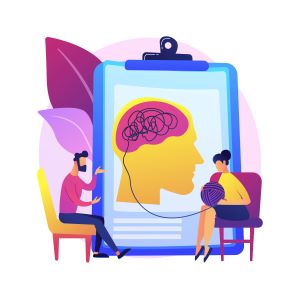Part of being human is occasional nervousness. As a kid, being called on in school when we didn’t know the answer, that first time speaking in front of people or for a class project or asking a girl on a date for the first time all of these could result in those feelings we often refer to as anxiety.
What is Anxiety?
Anxiety is the flight of the sympathetic central nervous system response to stressors. Imagine for a moment that you are going for a walk in the evening through your local park and a saber-toothed tiger jumps into your path. Your brain in a split second decides to either run or fight. Your brain decides to turn and flee back up the path and you do so. Your heart is racing, your thoughts are “RUN!”, muscles tremble from the immediate release of adrenaline and blood to the legs, you sweat and you may even get tunnel vision. You clear the park and jump into your car safely free from the threat of the tiger. Immediately your central nervous system begins to repair and you feel relief. These are all adaptive and effective responses to an actual physical threat because our brain wants to keep us alive.
However, what if it isn’t an actual physical threat? Instead let’s say that you went to the park to calm down after a stressful day. And instead of calming down, you are ruminating on your boss’s corrective action plan that you got earlier in the day and you are thinking about what could happen if you lose your job, then suddenly you have the same things happen? That is the engagement of the flight system as though you are having an actual physical threat. We have one system to deal with threats and though many of our modern threats are from psychological stressors, the body still has only one way to deal with the threat – either flee, fight or freeze.
Physical Response
We become aware of something whether it is a ferocious animal or a “what if” or “worst case” scenario we are running in our head and the body engages the sympathetic nervous system to get us out of danger and to safety.
The body prepares to run and a host of chemical and physical changes occur. The system is far more complex than described here, but simply put, the body begins to slow blood flow to the brain, shift resources from digestion, sexual responses and other routine systems to send blood and adrenaline to the legs, increases breathing and other changes such as sweating. The brain’s ability to complete complex computations is shut down because of the lack of blood and the brain usually focuses on getting away or running.
When this happens irregularly then it is what is often referred to as normal. A car cuts us off in traffic, public speaking, going to a new school or starting new jobs may be some of the environmental situations that result for many in anxiety reactions.
When Anxiety is a Problem
However when we engage the system fairly regularly and frequently, the conclusion unconsciously is that we live in a dangerous place so that we must be vigilant and always on the look out for dangers. Sadly this results in lots of false alarms and ever more sensitivities to engage the sympathetic system. Think of it like a car alarm set on very sensitive so that it goes off in the breeze or any touch whatsoever.
For us, constant engagement can seem to come out of nowhere but it can be environmental reminders such as seeing someone that reminds us of a past tormentor, a smell associated with a negative experience, or ruminating on what could go wrong. This hypervigilance can also lead to increased impatience and irritation. Almost always the ability to focus isn’t strong with someone with so many false alarms. Stands to reason that a brain that is hypervigilant will not be attending to the here and now but on the lookout for the next threat.
Association and Fear
Association happens when something occurs and our reaction is strong fear and confusion. Say for example that Mary is afraid of enclosed spaces. This came about because when she was a kid, her older siblings thought it would be funny to lock her in the closet as part of what they called hide-and-seek. She was afraid because it was dark and they left her in the locked closet for long periods. The brain also generalizes so that it isn’t only closets that she is afraid of but enclosed or tight spaces and even of the dark. The fear becomes learned and associated so that any time that she thinks that she has to go into a dark space or an enclosed space, she becomes very afraid and reports having anxiety or panic attacks.
One of the best nursery rhymes that describe how we develop phobias is Little Miss Muffet:
Little Miss Muffet
Sat on a tuffet,
Eating her curds and whey;
Along came a spider,
Who sat down beside her,
And frightened Miss Muffet away.
It often takes more than once, but if we are sufficiently scared and confused, it can be a one time event.
Avoidance is Fear’s Best Friend
Avoiding things that seem to bother us or in our minds cause anxiety may seem like an effective coping strategy. It isn’t. Say someone has a fear of crowded places and has to go to a big box store. They may drive around the parking lot getting more and more anxious as they see the number of cars and determine that there are just too many people inside the store. They drive away and immediately feel a sense of relief. What happens is then we begin to decide that smaller stores can have too many people as well. Over time the fears generalize from stores, to workplaces to family get togethers or jump to new fears. Instead of less anxiety, we have a significant increase in anxiety and a significant decrease in activities. In other words, our lives get very small.
Civilized Voodoo
Often we try to reduce the impact of anxiety in our lives and can do so in quite a few and ineffective ways. Sometimes we play out any possible scenario that could go wrong and become nearly paralyzed to do things. For example, as a young girl of 5 or 6, a past client I will call Cindy, remembered that she was left in a grocery store by a busy family. It wasn’t malicious but it was sufficiently fearful to the young Cindy. Over the years as an adult her anxious thinking became more and more generalized and paralyzing with the “worst case scenarios” that she wouldn’t leave town because she was afraid of so many different possibilities.
Sometimes we may engage in ritual behaviors such as looking for repeated patterns in numbers, knocking on wood, avoiding cracks or reciting lines from a song or story. If our fears are associated with death and health, we may double check locks, unplug all appliances, or avoid crowded places. We may obsessively check the weather for fears associated with weather related disasters. Other things can become rules that we have to follow from what time we can go somewhere to who we can be with and around.
All of these are attempts to feel safe, yet engaging in the activity doesn’t have any impact on the outcome. The temporary soothe the anxious person feels may seem like it has an impact. However, since it doesn’t work and there are times that things happen in spite of the soothing techniques, instead of abandoning the techniques we will do other things such as double down on our soothing efforts, avoid more places or situations or people. Or we will become more paralyzed by trying to come up with other “what if” scenarios.
Treatment for Anxiety Reactions
Anxiety is a very treatable issue. There are several techniques that can result in cessation of anxiety. One of the most effective forms of therapy for anxiety is cognitive behavioral therapy (CBT) that identifies and changes the fear provoking thoughts and patterns. Another form of therapy called behavioral therapy or exposure therapy can reduce the emotionality from the memories associated with anxiety and reduce sensitivity. Another therapy that is quite helpful is hypnosis. Through sessions of hypnosis a person can calm the over stimulated system and stop the false alarms. Another treatment that is helpful is mediation. It calms the overactive central nervous system much in the same way as hypnosis, but unlike hypnosis a person learns to shift attention away from the hypervigilance as opposed to suggestions that eliminate the false alarms.
Because of the didactic nature of CBT, many practitioners have adapted their type of CBT to be delivered through self-help books, self-guided therapy courses and apps. Many of these courses can be completed 100% free from a therapist or combined with therapy or coaching. One form of CBT called Rational Living Therapy often combines CBT and hypnosis. Review of the literature studies conducted as early as 2006 and continue today show that these self-directed programs work especially well for anxiety.
One thing to take into consideration is that if someone has significant impairment due to depression in which they can barely get out of bed or so afraid that they cannot leave their house, they maybe better suited for one-on-one services with a qualified professional.
Screening for Anxiety Reactions
You can take the Beck Anxiety Inventory here. The inventory is a screening tool that provides a score and understanding your score can help you to consider what your next steps can be. Remember as a screening tool, it cannot diagnose anyone. It is a tool to look at the impact that anxiety symptoms have in your life as a guide to seek additional services.
 Skip to content
Skip to content


